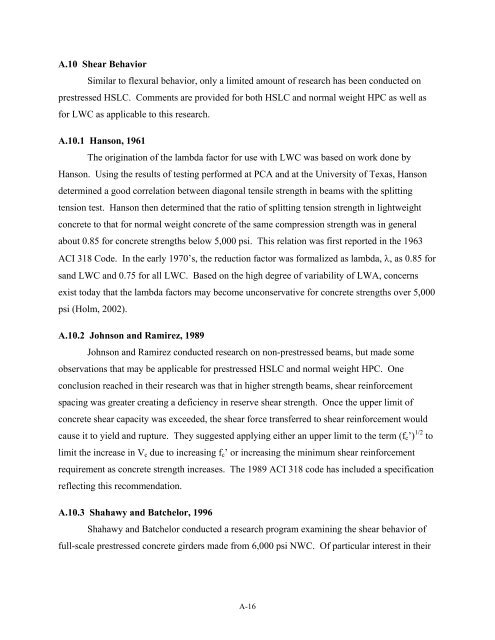Lightweight Concrete for High Strength - Expanded Shale & Clay
Lightweight Concrete for High Strength - Expanded Shale & Clay
Lightweight Concrete for High Strength - Expanded Shale & Clay
Create successful ePaper yourself
Turn your PDF publications into a flip-book with our unique Google optimized e-Paper software.
A.10 Shear Behavior<br />
Similar to flexural behavior, only a limited amount of research has been conducted on<br />
prestressed HSLC. Comments are provided <strong>for</strong> both HSLC and normal weight HPC as well as<br />
<strong>for</strong> LWC as applicable to this research.<br />
A.10.1 Hanson, 1961<br />
The origination of the lambda factor <strong>for</strong> use with LWC was based on work done by<br />
Hanson. Using the results of testing per<strong>for</strong>med at PCA and at the University of Texas, Hanson<br />
determined a good correlation between diagonal tensile strength in beams with the splitting<br />
tension test. Hanson then determined that the ratio of splitting tension strength in lightweight<br />
concrete to that <strong>for</strong> normal weight concrete of the same compression strength was in general<br />
about 0.85 <strong>for</strong> concrete strengths below 5,000 psi. This relation was first reported in the 1963<br />
ACI 318 Code. In the early 1970’s, the reduction factor was <strong>for</strong>malized as lambda, λ, as 0.85 <strong>for</strong><br />
sand LWC and 0.75 <strong>for</strong> all LWC. Based on the high degree of variability of LWA, concerns<br />
exist today that the lambda factors may become unconservative <strong>for</strong> concrete strengths over 5,000<br />
psi (Holm, 2002).<br />
A.10.2 Johnson and Ramirez, 1989<br />
Johnson and Ramirez conducted research on non-prestressed beams, but made some<br />
observations that may be applicable <strong>for</strong> prestressed HSLC and normal weight HPC. One<br />
conclusion reached in their research was that in higher strength beams, shear rein<strong>for</strong>cement<br />
spacing was greater creating a deficiency in reserve shear strength. Once the upper limit of<br />
concrete shear capacity was exceeded, the shear <strong>for</strong>ce transferred to shear rein<strong>for</strong>cement would<br />
cause it to yield and rupture. They suggested applying either an upper limit to the term (f c ’) 1/2 to<br />
limit the increase in V c due to increasing f c ’ or increasing the minimum shear rein<strong>for</strong>cement<br />
requirement as concrete strength increases. The 1989 ACI 318 code has included a specification<br />
reflecting this recommendation.<br />
A.10.3 Shahawy and Batchelor, 1996<br />
Shahawy and Batchelor conducted a research program examining the shear behavior of<br />
full-scale prestressed concrete girders made from 6,000 psi NWC. Of particular interest in their<br />
A-16















